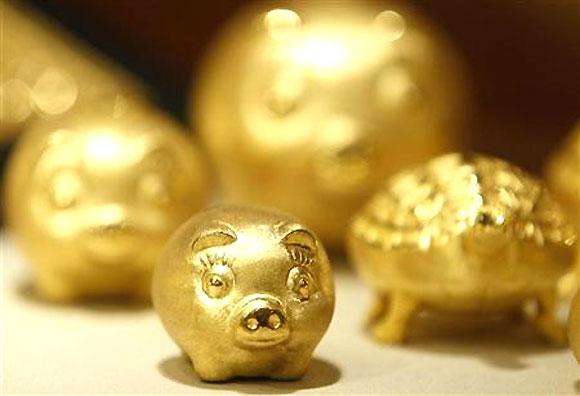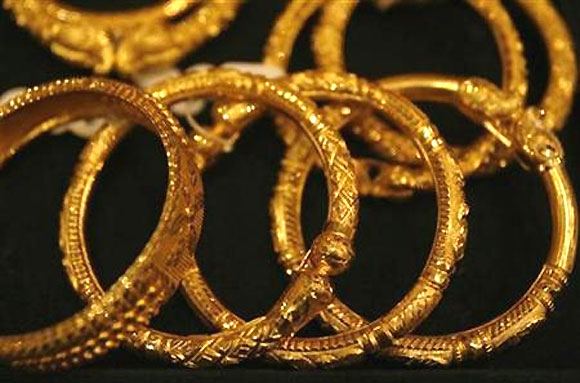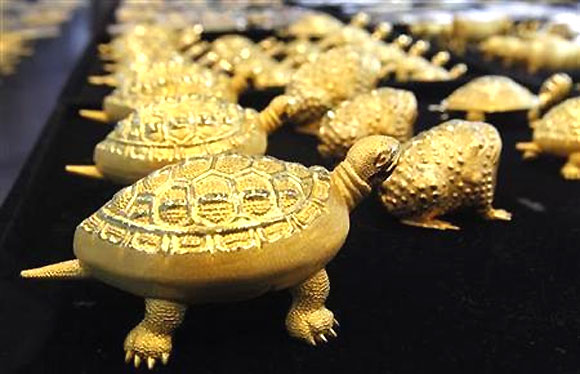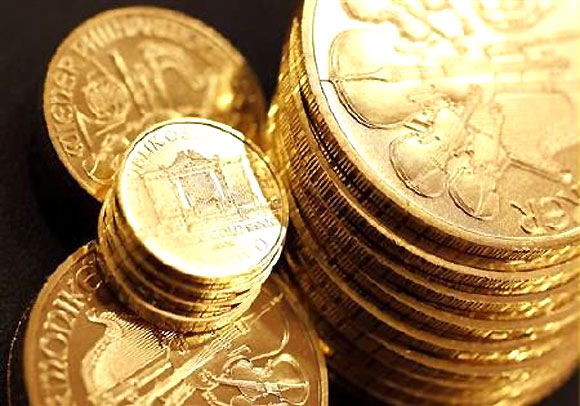 | « Back to article | Print this article |
Yellow fever: Spoiling the appetite for gold
Restrictions on gold by the Centre & RBI will help, but can these make gold unattractive for investors?
"I once again appeal to everyone to resist the temptation to buy gold. This will show a positive impact on every aspect of the Indian economy,” Finance Minister Palaniappan Chidambaram pleaded on Thursday, the second time in two weeks. Week before that, he had made a similar plea, asking banks to advise clients not to invest in gold. He followed it up by asking public sector banks not to sell gold coins.
The finance minister isn’t the only one. The Reserve Bank of India (RBI) has also come down hard on gold imports. Last week, it issued a diktat that banks could issue letters of credit to import only on a 100 per cent-cash-margin basis. Also, premier gold trading houses would only be able to import on a consignment basis to meet genuine demands of jewellery exporters.
For gold buyers and jewellers, the last year and a half haven’t been easy. The Centre, along with RBI, has declared an all-out war against the commodity. In January 2012, customs duty on gold stood at a little less than one per cent. Last week, it was raised to eight per cent. And, as mentioned earlier, gold imports have been cramped.
All this is not without reason. Gold imports are hitting India’s current account deficit (CAD) hard. For the quarter ended December 2012, CAD stood at a record 6.7 per cent of gross domestic product (GDP); it improved marginally to 5.7 per cent of GDP in quarter ended March.
Click on NEXT for more...
Yellow fever: Spoiling the appetite for gold
The clampdown on the yellow metal is a concern for companies such as Titan, Gitanjali and a host of small jewellers across the country. It is being reflected in their shares prices as well---almost all the listed firms in this segment have recorded substantial losses.
These companies were buying gold on loans or leases from banks and settling accounts after a few months. Since a large chunk of gold supplied to them was imported through the consignment route, the capital cost was negligible and there was no waiting period for physical gold.
Now, this would change. These companies would have to make full payments, which would increase their finance costs and hurt profits. “The new regime is negative for us, as there is a certain cost attached to gold imports. It would lead to reworking of cash flows,” said S Subramaniam, chief financial officer, Titan Industries.
While large companies may see reworking of cash flows and higher working capital, smaller jewellers would be hit harder. Smaller companies, which ordered only a few kilogrammes of the commodity, would find it difficult to import, as banks would prefer to wait for the consignment to become sizable, before an order. And, they would have to cough up the entire money upfront.
“The supply chain for smaller players has been significantly disturbed after RBI’s measures,” said Haresh Soni, chairman of the All India Gems and Jewellery Trade Federation.
Click on NEXT for more...
Yellow fever: Spoiling the appetite for gold
Another hurdle is many small jewellers have already used their credit lines from banks on the basis of their inventories. They would have to make the payments now, as banks may be reluctant to rollover these loans. Securing fresh loans by pledging gold would be quite difficult.
An official with a large capital market intermediary said the banking sector had dues of Rs 15,000-20,000 crore from small jewellers. In the absence of rollovers, these jewellers would have to find an alternative source of funding. Private equity players could come to their rescue, said a gold sector analyst.
The gold business per se is likely to become much more difficult. With an import duty of eight per cent, value-added tax of one per cent and the rupee languishing at 58, the scenario doesn’t look too bright. While there may not be any immediate impact because the demand for gold usually is weak in the months of June and July, with the onset of the festive season after August, the situation may worsen.
In April and May, gold imports soared to 300 tonnes, while demand was only 180 tonnes. Reason: The industry was worried RBI would come up with harsh guidelines, as indicated in the central bank’s monetary policy for 2013-14.
Click on NEXT for more...
Yellow fever: Spoiling the appetite for gold
Market experts said the demand for gold would be curtailed in the immediate run. Most peg the fall at 20 per cent, or about 200 tonnes. Gold imports aimed for export purposes, too, would fall, as round tripping (imports without significant value addition) wouldn’t be financially viable. Typically, round tripping is carried out to avail of the interest rate arbitrage.
This would reduce imports by an additional 10-15 per cent, or about 170 tonnes. In other words, the demand would fall by a good 40 per cent. And, the gold import bill is set to fall to $35-40 billion, against $53 billion last year. This is less than projected by C Rangarajan, chairman of the Prime Minister’s Economic Advisory Council.
There are fears the restrictions may lead to increased smuggling. Last year, an office bearer of the All India Gems and Jewellery Trade Federation said about 102 tonnes of gold had made its way into India through unofficial channels. Last year, India imported 1,071 tonnes of gold, while exports stood at 214 tonnes (170 tonnes accounted for by round tripping). About 600 tonnes of imports came through the consignment route by banks, under which the payment is made when the gold was actually sold to customers in India. About 400 tonnes of such imports was for domestic sale.
Industry players feel there would be increased smuggling activity, possibly to the tune of 150-160 tonnes. A veteran member of the Bombay Bullion Association said organised channels to smuggle the metal could emerge. Non-resident Indians and tourists, too, would find it lucrative to buy gold from abroad and bring it to the country.
Click on NEXT for more...
Yellow fever: Spoiling the appetite for gold
The cost benefits are significant: With import duty, cess, value-added tax and tax on cash sales (one per cent), the total cost of importing and selling gold rises by a good 10 per cent. In comparison, one kilogramme of gold would cost $4,160, or Rs 2.3 lakh. Financing illegal imports of the commodity has already opened a hawala market for dollars, and it would only deepen if vigilance isn’t stepped up.
As far as investors are concerned, RBI has introduced inflation-indexed bonds to counter threats. However, given these are benchmarked against wholesale price index-based inflation, these wouldn’t inspire much retail participation.
In fact, in the first auction of Rs 1,000 crore (Rs 10 billion) on June 4, only Rs 14 crore (Rs 140 million) was collected from retail investors, while the apex bank had reserved 20 per cent (Rs 200 crore) in the auction for the non-competitive section.
The primary reason for the lack of interest was the bonds were linked to the wholesale price index. As a result, the returns are slightly more than eight per cent, not enough at a time when the consumer price index - the true indicator of inflation for consumers - stands at a whopping 11 per cent.
From a jeweller’s perspective, imports would be difficult. Demand, too, would be curtailed due to the strictures. To ensure investors do not throng to the yellow metal, the finance minister and RBI would have to create alternative products that would give better returns. With equity markets going nowhere, gold has been among the best performers in the past five years, returning 17.38 per cent annually. In the past month, it provided 2.46 per cent returns (30 per cent annualised), owing to the depreciating rupee.
“If we don’t import gold for a year, the whole economic situation will change,” the finance minister had said on Thursday. Maybe true, but the challenge would be making gold unattractive, not exactly an easy task.





